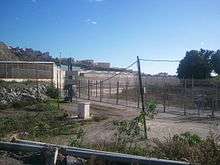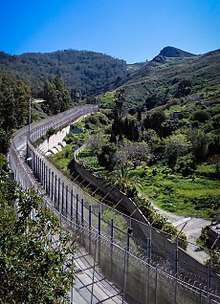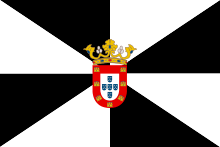Ceuta border fence

The Ceuta border fence forms part of the Morocco–Spain border[1] at Ceuta, a city on the North African coast. Constructed by Spain, its purpose is to prevent smuggling and to stop migrants from entering Europe. Morocco objected to the construction of the barrier since it does not recognize Spanish sovereignty in Ceuta.

Ceuta is an integral part of Spain, and therefore of the European Union; its border and its equivalent in Melilla are the only two land borders between the European Union and an African country.[2]
The fence consists of parallel 6 metre (20-foot)[3] fences topped with barbed wire, with regular watchposts and a road running between them to accommodate police patrols or ambulance service in case of need. Underground cables connect spotlights, noise and movement sensors, and video cameras to a central control booth; dozens of guard ships and patrol boats check the coast, while 621 Guardia Civil officers and 548 police officers control the shore.[4]
History
In 1993 an 8.4 km (5.2 mi) fence was built around the exclave. As the first fence was too easy to cross the construction of a new system started in 1995. In 2005 an increase of height was made, from 3 to 6 m (9 ft 10 in to 19 ft 8 in).[5]
Breaches
2005 attempted border breach
On 7 October 2005, the border-fence was assaulted by hundreds of migrants, creating international attention. Caught between the Spanish rubber bullets and Moroccan gunfire, a number of migrants died (sources put the number of deaths between thirteen[6] and eighteen people[4]) and more than fifty were injured. Some of the dead were wounded by live ammunition; of those, two died on the Spanish side of the fence,[6] apparently shot from the Moroccan positions.[7] The 2005 events at the Ceuta and Melilla border fences are the subject of a documentary film, Victimes de nos richesses.[8]
Since then, migrants have occasionally died while trying to break through the fence.[3][9]
2016 breach
The fence was breached by an organised group of 400 illegal entrants in December 2016. [10]
2017 breach
On 17 February 2017 an estimated 600 would-be undocumented migrants, some of whom were armed with clubs and shears, broke through the security gates; 300 of them are reported to have entered Ceuta where police are attempting to locate them.[11]
2018 breaches
- In June 2018, 400 migrants, the majority of whom were Moroccans, stormed the fence in Ceuta.[12]
- In July 2018, 602 Africans forced their way across the border using shears, sticks and edged weapons. The Africans sprayed corrosive substances, excrement and urine on police officers. 22 Spanish police officers were injured, four of them with major burns.[13] After this breach, the border was reinforced with more personnel, extra police vehicles and a helicopter equipped with night vision equipment.[14]
- In August 2018, of the hundreds that attempted it, more than 100 Africans forced their way into Ceuta, bringing the up to then 2018 total to 1400. The Africans threw excrement and corrosive substances at the Spanish policement, some of whom suffered burns. In total seven officers were wounded.[15][16] The following day 116 Africans were deported back across the border per a 1992 bilateral agreement between Spain and Morocco.[17][18][14]
See also
References
- ↑ Ferrer-Gallardo, Xavier; Albet-Mas, Abel (2016-07-01). "EU-Limboscapes: Ceuta and the proliferation of migrant detention spaces across the European Union". European Urban and Regional Studies. 23 (3): 527–530. doi:10.1177/0969776413508766. ISSN 0969-7764.
- ↑ Bilefsky, Dan (2017-02-20). "More Migrants Storm Fence to Enter Ceuta, Spanish Enclave in Africa". The New York Times. ISSN 0362-4331. Retrieved 2017-05-12.
- 1 2 "Spain/Morocco: Protect Migrants, Asylum Seekers". Human Rights Watch. Retrieved 8 November 2014.
- 1 2 Valsecchi, Riccardo (2009-06-25). "Ceuta, the border-fence of Europe". New York: WorldPress.
- ↑ Building Fortress Europe? Schengen and the Cases of Ceuta and Melilla
- 1 2 EUROPA - Press Releases - Visit to Ceuta and Melilla – Mission Report Technical mission to Morocco on illegal immigration 7 October– 11 October 2005
- ↑ Migrants shot dead at the border fence, Spain deploys army
- ↑ Barlet, Olivier. "Victimes de nos richesses". Africultures (in French). Retrieved 16 March 2012.
- ↑ "Spain: Accountability urged for 'appalling' migrant deaths in Ceuta". Amnesty International. Retrieved 8 November 2014.
- ↑ "Migrants Break IN". Euronews. 9 December 2016. Retrieved 12 December 2016.
- ↑ "Hundreds of migrants storm fence to reach Spanish enclave of Ceuta". BBC. 17 February 2017. Retrieved 17 February 2017.
- ↑ "Unos 400 inmigrantes intentan saltar la frontera de Ceuta y tres resultan heridos". El Huffington Post (in Spanish). 2018-06-06. Retrieved 2018-06-09.
- ↑ "Más de 600 inmigrantes entran en Ceuta tras saltar la valla: 22 guardias civiles heridos, varios por cal viva". ELMUNDO (in Spanish). Retrieved 2018-08-27.
- 1 2 "El Gobierno usa un acuerdo de 1992 para expulsar a los 116 inmigrantes que saltaron ayer la valla de Ceuta". ELMUNDO (in Spanish). Retrieved 2018-08-27.
- ↑ "DFer kritiseres for opfordring til at skyde migranter: »Nu må det være nok«". www.b.dk (in Danish). 2018-08-27. Retrieved 2018-08-27.
- ↑ Editorial, Reuters. "More than 100 migrants storm border of North African Spanish enclave". U.S. Retrieved 2018-08-27.
- ↑ "Migranter udvist til Marokko efter at have stormet enklave". www.b.dk (in Danish). 2018-08-23. Retrieved 2018-08-27.
- ↑ Rodero, Pablo. "Spain returns to Morocco migrants who stormed enclave fence". U.S. Retrieved 2018-08-27.
Bibliography in English
- Ferrer-Gallardo, Xavier. 2008. "The Spanish-Moroccan Border Complex: Processes of Geopolitics, Functional and Symbolic Rebordering." Political Geography 27: 301-321.
- Gold, Peter. 2000. Europe or Africa: A Contemporary Study of the North African Enclaves of Ceuta and Melilla. Liverpool: Liverpool University Press.
- Moffette, David. 2013. "Muslim Ceutíes, Migrants and Porteadores: Race, Security and Tolerance at the Spanish-Moroccan Border." Canadian Journal of Sociology 38(4): 601-621.
- Valsecchi, Riccardo. 2009. "Ceuta, the border-fence of Europe" WorldPress, 25 June 2009.
External links

- Spain: building border fence
- Ceuta, the border-fence of Europe
- Mustafa, the swimming fridge smuggler, and his macabre pact
- Attacking Europe's border fences
- Ceuta border fence photo gallery: 1 2 3 4 5 6 7 8 9
